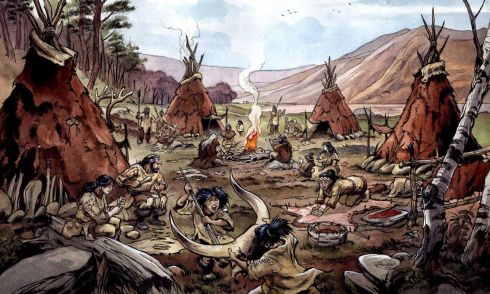Difference between revisions of "Clan (group)"
Tao alexis (talk | contribs) |
Tao alexis (talk | contribs) |
||
| Line 1: | Line 1: | ||
| − | [[File:Clan.jpg|right| | + | [[File:Clan.jpg|right|490px]] |
'''Clans''' are groups of humanoids united by actual or perceived family descent. They typically number between 20 and 50 members. In primitive regions, these are [[Hunting (technology)|hunter-gatherers]], but are more familiar as cottagers who collect to form an agricultural hamlet. The clan exists as a smaller, integral part of a larger society, such as a tribe, chiefdom or kingdom. As important part of the clan's integrity, marriages between members of one clan usually involve an exchange with other clans. With some humanoids, matrilineal, the male surrenders their former clan and indentifies as a member of the new clan. In patrilineal societies, it is the female who surrenders her former clan. | '''Clans''' are groups of humanoids united by actual or perceived family descent. They typically number between 20 and 50 members. In primitive regions, these are [[Hunting (technology)|hunter-gatherers]], but are more familiar as cottagers who collect to form an agricultural hamlet. The clan exists as a smaller, integral part of a larger society, such as a tribe, chiefdom or kingdom. As important part of the clan's integrity, marriages between members of one clan usually involve an exchange with other clans. With some humanoids, matrilineal, the male surrenders their former clan and indentifies as a member of the new clan. In patrilineal societies, it is the female who surrenders her former clan. | ||
Revision as of 02:41, 9 September 2020
Clans are groups of humanoids united by actual or perceived family descent. They typically number between 20 and 50 members. In primitive regions, these are hunter-gatherers, but are more familiar as cottagers who collect to form an agricultural hamlet. The clan exists as a smaller, integral part of a larger society, such as a tribe, chiefdom or kingdom. As important part of the clan's integrity, marriages between members of one clan usually involve an exchange with other clans. With some humanoids, matrilineal, the male surrenders their former clan and indentifies as a member of the new clan. In patrilineal societies, it is the female who surrenders her former clan.
Leadership
Clans are led by single persons, siblings or an agreement of elders, depending on how many "leaders" are present. A leader is a levelled character who has reached 1st level — usually as a fighter — through combat and experience rather than traditional fighter training. Because clans have a loose organization, and because there will usually be more than one leader, their power structure is usually egalitarian. Attempts to control others by force would be met with aggression and disobedience.
Nominally, therefore, a single leader may be recognized as the strongest member and be called "chief." This should not be confused with the levelled Chieftain non-player character — it means only the nominal leader of the clan. Two leaders may be "siblings," either in fact or in name, together calling themselves "chief" while sharing authority. Or the leader may represent a collection of elders, who in turn would call him "chief." The nominal chief may not be the strongest levelled character; perhaps intelligence or wisdom is prized by the elders.
It is the chief's role to carry forward custom, give consent to the day's activity and most important to give recognition to those in the clan who have acted well. The role is supportive and giving, and not dictatorial.
Able Members
| Role | Number |
|---|---|
| Leader | 1-4 |
| Brave | 1-3 per leader |
| Hunter | 2-5 per leader |
| Caretaker | 2-8 per leader |
| Dependent | 1-4 per leader |
For lack of a more universal term, braves are non-levelled clan warriors who yet possess hit points in excess of ¾ the maximum possible for their hit dice. For example, a humanoid who received d8 hit points per hit die could be counted a "brave" if they had 7 or 8 hit points (6 would be equal to ¾ exactly, and would therefore not be enough for a brave). A clan's War Party consists of all the braves and one chosen leader. While braves participate in hunts, they usually act as beaters, as they are most likely to meet with the prey face-to-face as it is driven into the open.
Hunters are hearty, capable members of the clan who will possess better than ⅜ the maximum hit points possible, up to ¾.
WORKING...
